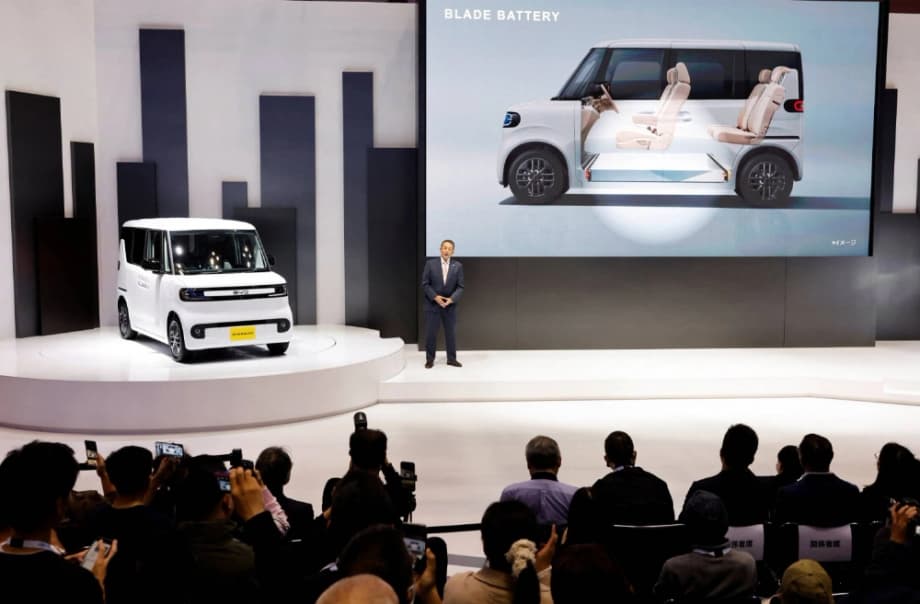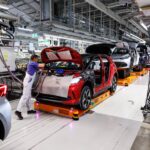BYD makes a bold play at the Japan Mobility Show
China based BYD used the Japan Mobility Show to stake a larger claim in one of the worlds most distinctive auto segments. The company pulled the cover off Racco, a compact battery electric kei car engineered specifically for Japanese roads and regulations. The debut signals a deeper push into Japan at a time when battery electric cars remain a niche, yet kei cars dominate urban mobility and household budgets.
- BYD makes a bold play at the Japan Mobility Show
- Meet Racco, a kei EV built for Japan
- Price, range and charging
- Why kei cars matter in Japan
- Competition and how Racco stacks up
- A wider push, from EV to plug in hybrid and commercial vehicles
- Policy signals and a changing market
- What drivers should expect day to day
- Risks and unknowns
- Highlights
During a press preview, BYD executives said the company is fully committed to Japan and will roll out models shaped for local tastes and rules. The spotlight model is the Racco, a pint sized city car scheduled to reach Japanese buyers in the summer of 2026. The move makes BYD a rare foreign entrant in Japan’s kei jidosha class, a category that accounts for a large share of national auto sales and is traditionally ruled by domestic brands.
Kei cars, capped by strict size and power limits, are popular with cost conscious owners who value easy maneuvering on narrow streets and lower ownership costs. BYD’s bet is that a simple, quiet electric kei car, priced in line with local favorites, can win shoppers who want a practical commuter that charges at home and frees them from trips to the gas station.
The company’s footprint in Japan is expanding. BYD operates dozens of retail locations and is adding more stores and service points to cover all 47 prefectures by the end of next year. Sales of BYD battery electric cars in Japan remain modest compared with the overall market, but the brand is gaining recognition and is now moving into the segment where electric demand is growing fastest.
Meet Racco, a kei EV built for Japan
Racco fits the kei template to the millimeter. It measures 3,395 mm in length, 1,475 mm in width, and 1,800 mm in height. The tall, upright body maximizes interior space. Short overhangs and wheels at the corners help the little car pivot through tight neighborhoods and squeeze into compact parking spaces. Rear sliding doors make entry easier in cramped spots, a feature many families and delivery drivers value in kei cars.
The exterior wears a clean face with a closed grille, a signature of many electric cars that do not need large radiator openings. C shaped daytime running lights sit high for visibility, and a full width rear light bar ties the tail together. A double A pillar design improves forward visibility at junctions. Details like a charge port on the front fender and a partially blacked out C pillar to create a floating roof effect show how BYD tried to merge kei practicality with modern styling.
Inside, the dashboard follows a minimalist layout. A central touchscreen sits above a row of physical buttons for routine functions. A compact digital instrument cluster gives essential driving info. The rear bench slides and folds to trade legroom for cargo volume, a useful trick in a small footprint. The overall cabin design aims to be simple to use for daily commuting while providing the tech features buyers now expect, such as smartphone integration and basic driver assist tools for low speed urban driving.
The name Racco comes from rakko, the Japanese word for sea otter. It joins BYD models named after marine life, such as Dolphin, Seal, and Sealion. That branding thread is now extending into a class of car invented in Japan and beloved by Japanese drivers.
Price, range and charging
BYD has not published a full spec sheet, but the plan is straightforward. Racco is expected to carry a Blade lithium iron phosphate battery around 20 kilowatt hours, targeting roughly 180 kilometers of range on the WLTC test cycle used in Japan. That rating aligns well with common urban use patterns and keeps weight and costs in check. Reports in regional media mention the possibility of a second, longer range variant, though BYD has not confirmed an additional battery size.
Output will comply with kei rules, which limit peak power to roughly 63 horsepower. That keeps acceleration modest yet adequate for city driving and suburban errands. For buyers comparing monthly expenses, the small battery should help deliver a competitive list price. Industry watchers expect a starting price around 2.5 million yen, in line with the Nissan Sakura, currently the best selling electric passenger car in Japan.
Preorders are expected in summer 2026, with initial deliveries around the same time. Final battery details, charging specs, and exact pricing are set to be announced closer to launch. BYD says the model is designed for Japan and will be sold exclusively in the country at the outset.
Why kei cars matter in Japan
Kei cars are a uniquely Japanese solution to everyday mobility. They are capped at 3,400 mm in length and 1,480 mm in width, and their power is limited to keep performance suitable for dense cities. In return, owners receive lower taxes and inspection fees, and the cars are easier to live with where space is tight. For many households a kei car is the daily runabout, used for grocery trips, school drop offs, and commuting on local roads.
Electrifying this class can make a measurable difference in city air quality and noise. Short trip driving with frequent stop and go is where electric propulsion shines. Owners who can charge at home or at work are well positioned to take advantage of lower running costs. Government purchase incentives and tax breaks for electric models can further reduce upfront costs, though program terms are periodically adjusted.
Japan’s overall battery electric market share is still small compared with Europe and China, yet kei cars have remained a bright spot for electric adoption. About 1.55 million kei cars were sold last year, representing roughly a third to 40 percent of new vehicle sales. That sheer volume is why a compelling electric kei car can move the needle for electrification, even if long range highway cruisers remain a rarer sight.
Competition and how Racco stacks up
Racco is entering a segment that already has capable local choices. The Nissan Sakura and its sibling, the Mitsubishi eK X EV, set the early benchmark for electric kei cars with compact footprints, approachable pricing, and around town range that fits daily needs. Honda dominates the kei segment with gasoline models like the N Box, and it is preparing new electric entries for the years ahead. Suzuki and Daihatsu, pillars of the kei world, are also developing compact electric products.
BYD’s advantage is battery scale, vertical integration, and experience squeezing costs out of small electric cars. The company’s Blade battery has built a reputation for safety and durability, and a 20 kilowatt hour pack can be built and sold at a competitive price. Racco’s sliding rear doors and boxy roofline play to the practical tastes of kei buyers, while a simple digital interior meets the expectations of younger drivers switching from smartphones to steering wheels.
Price will decide much of the battle. The Sakura starts around the mid 2 million yen range, and Honda and others are signaling similar targets for their electric kei offerings. If BYD can come in at or below these rivals while matching range and charging convenience, Racco will force incumbent brands to respond. If pricing drifts higher, brand loyalty and dense dealer networks could keep many shoppers within the Japanese fold.
A wider push, from EV to plug in hybrid and commercial vehicles
BYD’s Tokyo stand went far beyond one small car. The company used the show to outline a dual track strategy for Japan, pairing battery electric models with a new plug in hybrid line. The Sealion 06 DM i, a compact sport utility vehicle with BYD’s latest hybrid system, marks the brand’s first plug in hybrid for Japan. The message is that some buyers will jump straight to battery electric, while others will value a hybrid bridge, and BYD intends to serve both paths.
On the passenger car side, BYD displayed updated versions of its Dolphin and Seal, alongside Atto 3 and the forthcoming Sealion 7. At the other end of the spectrum, the company rolled out the Yangwang U9, a flagship electric supercar that showcases the group’s technology depth, from motors and power electronics to chassis control.
The commercial lineup underscores how BYD plans to compete across segments. The T35, a light duty electric truck tailored to Japanese size and weight rules, is due on sale in 2026. A J6 Living Car mini bus concept joined the existing J7 medium size and K8 large electric buses. BYD says hundreds of its buses already operate in Japan, a base that can help it build service expertise and brand familiarity in the country.
Retail coverage is expanding. BYD counts dozens of stores in Japan today and is opening more showrooms and service bays, with a target to reach every prefecture. The brand has indicated it aims to offer seven to eight battery electric and plug in hybrid passenger models in Japan by 2027, giving shoppers a clearer ladder from affordable city EVs to larger family vehicles.
Liu Xueliang, General Manager of BYD Asia Pacific Auto Sales Division, framed the company’s showing as an inflection point after years of groundwork in Japan.
“From electric buses to electric cars and now Super Hybrid DM i models, we want to offer safe, efficient, and high quality new energy vehicles suited to Japan’s needs. We will keep strengthening our services, expanding our lineup, and working with customers across Japan for a more sustainable future.”
Policy signals and a changing market
Government officials have made clear they see global competition in electric vehicles as healthy and do not intend to resort to trade barriers. Policymakers are, however, reviewing how subsidies and tax credits are allocated, and adjustments have trimmed benefits for some imports over the past year. That means foreign brands need a value proposition that stands on its own, and kei car level affordability is an attractive route.
Japanese automakers remain strong in hybrids, a technology that fits local driving patterns and keeps fuel consumption low. A credible foreign electric kei car arriving on home turf is a timely nudge to accelerate domestic plans. Honda is preparing new small EVs, Nissan is refreshing its electric portfolio, and Suzuki and Daihatsu are tapping their kei expertise for compact electric platforms. The pace of change is picking up, and the segment that matters most for volume is now the one facing a direct challenge from abroad.
Another undercurrent is pricing pressure fueled by a competitive market in China. Chinese brands, including BYD, have been looking overseas for growth as domestic competition compresses margins. That dynamic is already visible in Southeast Asia and may keep Japanese prices competitive, to the benefit of consumers who prioritize value above all else.
What drivers should expect day to day
For urban drivers, a small electric car with a 20 kilowatt hour battery can be easy to live with. Typical commute and errands in Japanese cities are short, and many owners can plug in at home overnight using a standard wall box. Even drivers without home charging often have access to workplace or neighborhood chargers that can top up the battery while the car is parked.
Charging speed matters most on busy days. While BYD has not released final numbers, a pack of this size does not require long sessions to refill. Even at moderate fast charge power, a top up from around 20 percent to 80 percent can take on the order of 15 to 30 minutes, depending on the station and the cars thermal management. That makes quick charging at a shopping center or rest area a practical option when needed.
Ownership costs are another selling point. Electric drivetrains have fewer moving parts and lower routine maintenance needs than combustion engines. Kei cars already benefit from lower taxes and inspection costs, and electric kei cars can add fuel savings to that equation. The main hurdle is still upfront price. That is where BYD’s scale in batteries and components, and its willingness to build a car precisely for Japanese rules, could make a tangible difference for household budgets.
Risks and unknowns
A successful launch will depend on a few factors that are not yet settled. Final battery and charging specifications are pending. The list price, and how much of it is offset by incentives, will shape demand. Brand acceptance matters, especially in a category where neighborhood dealerships and long relationships with domestic makers are common. Service coverage and parts availability need to grow in step with sales.
There are also market variables outside of BYD’s control. Subsidy rules may evolve again. Exchange rates can influence import pricing. Domestic brands could accelerate their own kei EVs and engage in sharper price competition. Still, the decision to design a kei EV solely for Japan is a signal of intent. Racco is meant to compete on the playing field that counts most for volume, and it will test how far a new entrant can go in a segment defined by practicality and price.
Highlights
- BYD unveiled Racco, a Japan specific electric kei car, at the Japan Mobility Show
- Dimensions meet kei limits, with a tall body, sliding rear doors, and space focused packaging
- Expected 20 kilowatt hour Blade battery targets about 180 kilometers WLTC range
- Pricing is anticipated around 2.5 million yen, similar to Nissan Sakura
- Sales planned to begin in summer 2026, with final specs and price to be confirmed
- Move marks a rare foreign entry into a segment that accounts for roughly one third to 40 percent of Japans auto sales
- BYD is pursuing an EV plus PHEV strategy, debuting the Sealion 06 DM i alongside Racco
- Commercial lineup includes the T35 electric truck and electric buses, with Japanese sales slated in 2026
- BYD is expanding retail coverage and aims to operate in all 47 prefectures by the end of next year
- Domestic rivals are preparing more kei EVs, setting up a price and value contest in Japans most important segment












